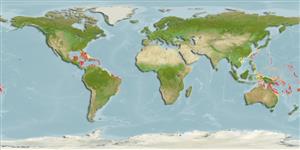Common names from other countries
Environment: milieu / climate zone / depth range / distribution range
Ecologia
; intervalo de profundidade 2 - 61 m (Ref. 108813). Tropical
Western Atlantic and Western Central Pacific.
Length at first maturity / Tamanho / Peso / Idade
Maturity: Lm ? range ? - ? cm Max length : 10.0 cm OT macho/indeterminado; (Ref. 415)
Massive; flabellate; rising from a narrow base: 1.5 - 10 cm thick. Bright red-orange externally, lighter internally. The margin is rounded, or indented. Compressible, resilient. The surface is rough to be touch to verrucose, with abundant membrane-bearing oscula: 0.2 - 0.5 cm in diameter (Ref. 415). Color range from orange to brown (Ref. 81728).
Maximum thickness: 10 cm (Ref. 415). Maximum depth reported taken from Ref. 128739. Found in coral reefs, usually below 10 m in depth (Ref. 415), and on rocky bottoms (Ref. 83912). It hosts alpheid shrimps, i.e., Synalpheus spp. in its canals (Ref. 86672). Inhabits shallow and mesophotic coral reefs along with coral communities and coralline algae reefs (Ref. 128739).
Life cycle and mating behavior
Maturidade | Reprodução | Desova | Ovos | Fecundidade | Larvas
Members of the class Demospongiae are hermaphroditic. Life cycle: The zygote develops into parenchymella larva (free-swimming) before settling down on a substrate where it grows into a young sponge.
Collin, R., M.C. Díaz, J. Norenburg, R.M. Rocha, J.A. Sánchez, M. Schulze, A. Schwartz and A. Valdés. 2005. (Ref. 415)
Status na Lista Vermelha da IUCN (Ref. 130435)
Status no CITES (Ref. 108899)
Not Evaluated
Not Evaluated
Perigo para os humanos
Harmless
Uso pelos humanos
| FishSource |
Ferramentas
Mais informação
Idade/TamanhoCrescimentoComprimento-pesoComprimento-comprimentoMorfologiaLarvasAbundância
Fontes da internet
Estimates based on models
Preferred temperature
(Ref.
115969): 26 - 28.3, mean 27.2 (based on 435 cells).
Vulnerabilidade
Low vulnerability (10 of 100).
Categoria de preço
Unknown.
